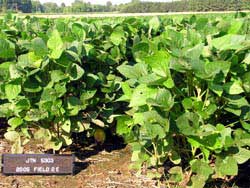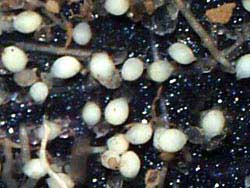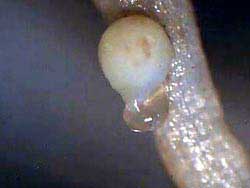Jackson, Tennessee
September 29, 2005
|
 |
|
The
new soybean line was tested at the UT West Tennessee
Research and Education Center in Jackson. Photo courtesy
of USDA-ARS. |
The USDA Agricultural Research Service and the
University of Tennessee
Agricultural Experiment Station have announced the release
of an important new soybean germplasm. The new genetic material
has the potential to increase farmers' income by millions
nationwide, but should be especially beneficial to producers in
the Mid South.
Designated as JTN-5303, the new line is characterized by high
seed yields and high levels of resistance to multiple races of
soybean cyst nematode (SCN).
SCN is the most serious soybean pest in the United States. Dr.
Prakash Arelli, a soybean breeder with the USDA-ARS Crop
Genetics and Production Research Unit in Jackson says an SCN
infestation can reduce a field's yield by as much as 30 percent.
“Current estimates say American farmers' earnings are reduced by
soybean cyst nematodes by as much as $1.1 billion annually,”
Arelli said. He notes that aggressive nematode populations
have been identified in the Mid South.
|
 |
|
Soybean cyst nematode cysts can be loose in the soil
(above) or attached to a root (below). Photos courtesy
of USDA-ARS. |
|
 |
The new soybean line, which was
jointly developed by the USDA-ARS and UT Agricultural Experiment
Station, is also highly resistant to potentially devastating and
expensive fungal diseases including stem canker and frogeye leaf
spot. It is moderately resistant to sudden death syndrome and
experiences lower degrees of disease severity due to charcoal
rot.
JTN-5303 is a maturity group V soybean that is well adapted to
production in the Mid South, which has more acreage planted with
soybeans than any other row crop.
The scientists developed the new line by combining genes from
different sources of SCN resistance. "We used classical breeding
techniques to transfer SCN resistance genes into high-yielding
soybeans," said Dr. Vince Pantalone, lead researcher with the UT
Soybean Breeding and Genetics Program and an associate professor
in the UT Department of Plant Sciences.
Pantalone, Arelli, Fred Allen, a UT professor of plant sciences,
and Alemu Mengistu, with the USDA-ARS in Jackson, collaborated
to develop the new germplasm.
JTN-5303 seeds will be used by breeders in developing and
commercializing new cultivars. They will be maintained by the
USDA-ARS Crop Genetics and Production Research Unit in Jackson
for five years. Small quantities of seed can be requested until
supplies are exhausted.
The UT Soybean Breeding and Genetics Program is well recognized.
Two of the varieties developed by the university are so
productive and well-adapted to the Mid South, Southeast, and Mid
Atlantic that they were named check varieties for the USDA
Southern Uniform Testing Program. The USDA program allows
breeders to identify and release better performing varieties for
the region.
The two check varieties developed by UT, 5601T and 5002T,
replaced Hutcheson and Manokin, in 2003 and 2004 respectively.
Both Hutcheson and Manokin served as the USDA checks and have
been household words in the soybean industry for the previous
decade.
New
Soybean Resists Nematodes and Pathogens
ARS News Service
Agricultural Research Service, USDA
Jim Core, (301) 504-1619,
jcore@ars.usda.gov
High seed yield and unique
resistance to nematodes and several diseases are the key
qualities of new soybean lines developed by the Agricultural
Research Service (ARS) and the Tennessee Agricultural Experiment
Station in Knoxville.
The release of soybean lines JTN-5303 and JTN-5503 was announced
today in Jackson, Tennessee, during a ceremony hosted jointly by
ARS and the experiment station.
According to Prakash R. Arelli, a geneticist at the ARS
Nematology Research Unit in Jackson, the new lines have broad
resistance to multiple races of soybean cyst nematode (SCN).
This is the most destructive soybean pest in the United States,
causing an annual estimated loss of $1.1 billion.
JTN-5303 is a cross between the cultivars Caviness and Anand,
while JTN-5503 is a cross between Fowler and Manokin.
Traditional breeding techniques and marker-assisted selection
were used to track resistance genes. Both lines have yields
significantly higher than the popular cultivars Hartwig, Fowler
and Anand, and have Hartwig-type resistance to widespread
nematode populations.
Both lines were also selected for resistance to several fungal
pathogens, including sudden death syndrome, stem canker, and
frogeye leaf spot, with moderate resistance to charcoal rot.
Previous lines have never had this unique combination of
resistance to both SCN and pathogens.
The new releases are in Maturity Group V. Maturity groups are
used to designate which varieties are best suited for production
in specific geographic regions. The new lines are well adapted
to production in the Mid South.
Arelli developed the new lines with Vince Pantalone and Fred
Allen, geneticists at the University of Tennessee. They were
assisted by ARS scientists Lawrence Young, Arelli's research
leader, and Alemu Mengistu, a soybean pathologist.
These lines are expected to be ideal choices for breeders for
use as parents in developing cultivars in early maturity groups
that reduce soybean yield losses and reduce the need for
pesticides.
ARS is the U.S. Department of
Agriculture's chief scientific research agency.
Nuevas líneas de soya tienen resistencia a los nematodos y
patógenos
Servicio Noticiero del Servicio de Investigación Agrícola (ARS
siglas en inglés)
Departamento de Agricultura (USDA siglas en inglés)
Jim Core, (301) 504-1619,
jcore@ars.usda.gov
Los rendimientos altos y una
resistencia única a nematodos y varias enfermedades son las
características claves de nuevas líneas de soya desarrolladas
por el Servicio de Investigación Agrícola (ARS) y la Estación de
Tennessee de Experimentos Agrícolas en Knoxville, Tennessee.
El lanzamiento de las líneas JTN-5303 y JTN-5503 fue anunciado
hoy en Jackson, Tennessee, durante una ceremonia albergada
conjuntamente por ARS y la estación agrícola.
Según Prakash R. Arelli, un genetista en la Unidad de
Investigación de Nematología mantenida por ARS en Jackson, las
nuevas líneas tienen una amplia resistencia a cepas múltiples de
los nematodos de los quistes de la soya (SCN por sus siglas en
inglés). Esta es la plaga más destructora de soyas en EE.UU.,
causando pérdidas estimadas de 1,1 mil millones de dólares
anualmente.
JTN-5303 es un cruce de las variedades 'Caviness' y 'Anand',
mientras JTN-5503 es un cruce de las variedades 'Fowler' y
'Manokin'. Las técnicas tradicionales de crianza y la selección
asistida por marcadores fueron usadas para encontrar los genes
que proveen la resistencia. Ambas líneas producen rendimientos
significativamente más altos que los de los cultivares populares
'Hartwig', 'Fowler' y 'Anand'. Las líneas también tienen una
resistencia igual a 'Hartwig' a las poblaciones extensas de
nematodos.
Los investigadores seleccionaron las líneas para su resistencia
a varios patógenos fungales, incluyendo el síndrome de la muerte
repentina de la soya, el cancro del tallo, y la mancha en ojo de
sapo. También tienen resistencia moderada a la podredumbre
carbonosa de soya. Líneas previas no han tenido esta combinación
única de resistencia al SCN y los patógenos.
Los lanzamientos nuevos son en el Grupo de Madurez V. Los grupos
de madurez se usan para indicar cuáles de las variedades son
apropiadas para producción en una área geográfica específica.
Las nuevas líneas son bien adaptadas para producción en la
región del Medio Sur.
Arelli desarrolló las nuevas líneas junto con Vince Pantalone y
Fred Allen, quienes son genetistas en la Universidad de
Tennessee. Otros participantes en el proyecto fueron Lawrence
Young, el líder de investigaciones en el laboratorio donde
trabaja Arelli, y Alemu Mengistu, un patólogo de soya con ARS.
Se espera que estas nuevas líneas serán selecciones ideales para
los cultivadores de nuevas variedades. Ellos pueden usar estas
líneas como padres en el desarrollo de variedades en grupos de
madurez temprana para reducir pérdidas de rendimientos y también
reducir la necesidad de pesticidas.
ARS es la agencia principal de investigaciones científicas
del Departamento de Agricultura de EE.UU. |